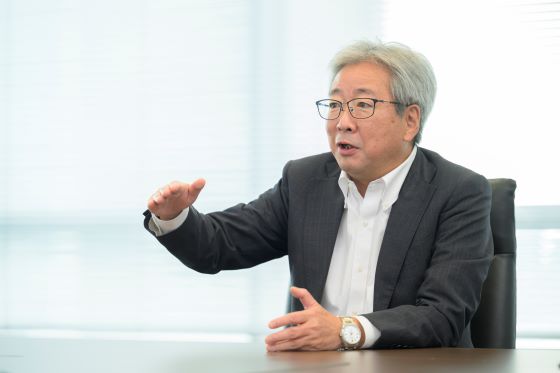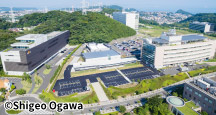Based on our long-term vision “Nifco makes Ideas a Reality ," we are strengthening our organization and reviewing our corporate philosophy framework, aiming to be a company that can contribute to the survival of society.
Masaharu Shibao
Representative Director, President & CEO

Interview date: August 2024
Seeing social issues as opportunities, including major changes in the automobile industry
Since assuming the position of CEO in 2023, I have taken a longer-term perspective and have begun undertaking various initiatives with ESG in mind to consider how Nifco can continue to grow sustainably over the next several decades and beyond. The impetus behind this has been a major transformation of the automotive industry. Our main products are automotive parts, so in the past, our business was able to run by formulating and implementing management plans in line with finished vehicle manufacturers' production plans. Lately, however, the situation has changed. Yet, this change also represents a great opportunity. As a company, it is our job to view the various social issues that are currently occurring and that may arise in the future, including the major transformation of the automotive industry, as opportunities, and to contribute to society by creating new businesses, for example.
This is why our long-term vision and our social mission is “Nifco makes Ideas a Reality." When we think of ideas, we tend to think of ideas for products (things), and for many years our company has been turning a wide variety of ideas into products and supplying them to the world. However, “ideas” here means creating business concepts related to “experiences” or “services” that can solve social issues, and developing businesses that contribute to society while growing our company.
Creating a strong organization by establishing three tiers based on age demographics

To realize this long-term vision, everyone, from management to employees, must have a sense of ownership and pass the baton to the next and future generations Nifco is a company that operates globally across six regions, including not only Japan but also North America, Europe, Southeast Asia, China, and Korea, so it is essential that we share the same vision across all regions.
One of the initiatives we have launched to achieve this is to create a strong organization by setting up three tiers based on age demographics. The first tier consists of top management from each region, the second tier comprises business site managers, and the third tier is made up of mid-career employees around the age of 40. Each tier will have roughly 20 people, with participants rotated as necessary, and meetings of each tier will be held about twice a year. In a sense, the role of the first tier is to talk about dreams, discuss the vision for what the company should be in the future, and set guidelines for achieving that. The second tier is a group whose mission is to achieve the commitments made in the Mid-Term Management Plan (FY2024 - FY2026), and they discuss issues and measures to achieve the goals. The third tier discusses what kind of company we want to be when they imagine a future in which they will be the main players, that is, as top managers or executives.
We believe that if these meetings allow each level to share information and understand who is strong in what in which region, and who they should approach to make business go more smoothly, the organization will be strengthened. In addition, meetings for the third tier, the youngest people in the three tiers, are generally held in English. The hope is that by making it in English, participants will be able to access business and human resources information that is not available in Japanese-speaking environment . I believe that the most important thing in a company is people. Unearthing the talent that lies dormant not only in Japan but elsewhere in the world is a prerequisite for growth.
Reviewing the corporate philosophy system and increasing employee engagement

Increasing employee engagement is essential to building a strong organization. To achieve this, we undertook a review of our corporate philosophy system. The key point is that it starts from each employee's individual “My Purpose,” as shown in the diagram below. Everyone has their own values and outlook on life that they hold dear in life, such as “this is what I was born to do” or “this is how I want to contribute to society.” Where those things overlap with the company's “Purpose” is “My Purpose.” In other words, it all starts with how each of us can utilize our own values within the company. I hope that this will encourage everyone to take the initiative in thinking about how they can contribute to the company.

I also feel very strongly about the importance of disseminating information, and place an emphasis on communicating both internally and externally. In order to ensure that employees have a deep understanding of things within the company, whether it's the Mid-Term Management Plan or My Purpose, I find that it's better for me to visit them in person, whether in Japan or overseas, and explain it. As we meet face-to-face many times, our discussions gradually become more in-depth and we gain insights for steering the business forward.
At the same time, communicating Nifco's initiatives to the outside world will help enhance corporate value. We will also focus on promoting new products and brand building for Nifco. Because Nifco is a B2B company, it is not well known outside the automotive industry. Through brand building, however, we hope to increase awareness of our name and have many talented people become aware that a company called Nifco exists. I am convinced that recruiting human resources will also lead to the creation of new businesses, which I will talk about next.
Three strategic points in the Mid-Term Management Plan

Our Mid-Term Management Plan for the next three years (FY2024-FY2026) has been formulated based on three strategic concepts. The first is growth investment. Although there were some losses due to the transfer of subsidiaries that had issues, we were able to largely achieve Mid-Term Management Plan targets for FY2021 to FY2023 (ended March 2024). However, we were unable to make growth investments despite having ample funds. During the next Mid-Term Management Plan period, we plan to allocate tens of billions of yen to new businesses, and will not insist on self-reliance but will instead invest in startup companies and engage in M&A in order to launch new businesses. The businesses are expected to place an emphasis on ESG.
The second strategic concept is “glocal management.” Up until now, our company has operated a business model of developing products in Japan and selling them worldwide, but achieving sustained growth will require more than that. We are considering delegating a certain amount of authority to the head of each region so that they can respond quickly to projects that are suited to local characteristics and needs. We also aim to create locally-led businesses, that is, launch new businesses within the automotive industry. Our two main pillars of growth will be the new businesses mentioned in the above growth investment section (the first strategic concept), and business creation through glocal management.
The third is improving employee engagement, as I mentioned earlier. One of the means for improving this is establishing My Purpose, as mentioned above. I experienced this myself at a purpose training session we recently held for executive officers. Trainees had to actually think about the connection between their own My Purpose and the company's purpose, and find a path for applying their own values and outlook on life within the company. We will also further promote diversity to revitalize our organization and secure the next generation of talent.
In addition, we will further advance our efforts to achieve carbon neutrality and protect the environment. Our main products are plastic parts used in automobiles. While using plastic would seem to go against the intent of our environmental measures, using plastic actually reduces the weight of the finished vehicle and improves fuel efficiency, which in turn has the overall effect of reducing CO2 emissions. Though this example represents an indirect contribution to environmental protection, we will continue to seek out further ways to make environmental protection a part of our business operations. In addition, while electricity consumption is essential for manufacturing, we will work to reduce CO2 emissions and costs through means such as installing solar panels.
Message to Stakeholders
Nifco strives to solve social issues through its business and aspires to be a company that can contribute to the survival of society. Naturally, for this to happen, Nifco itself must be a company that can survive into the future. So how will the company survive? This is something I hope you will keep an eye on and look forward to.




